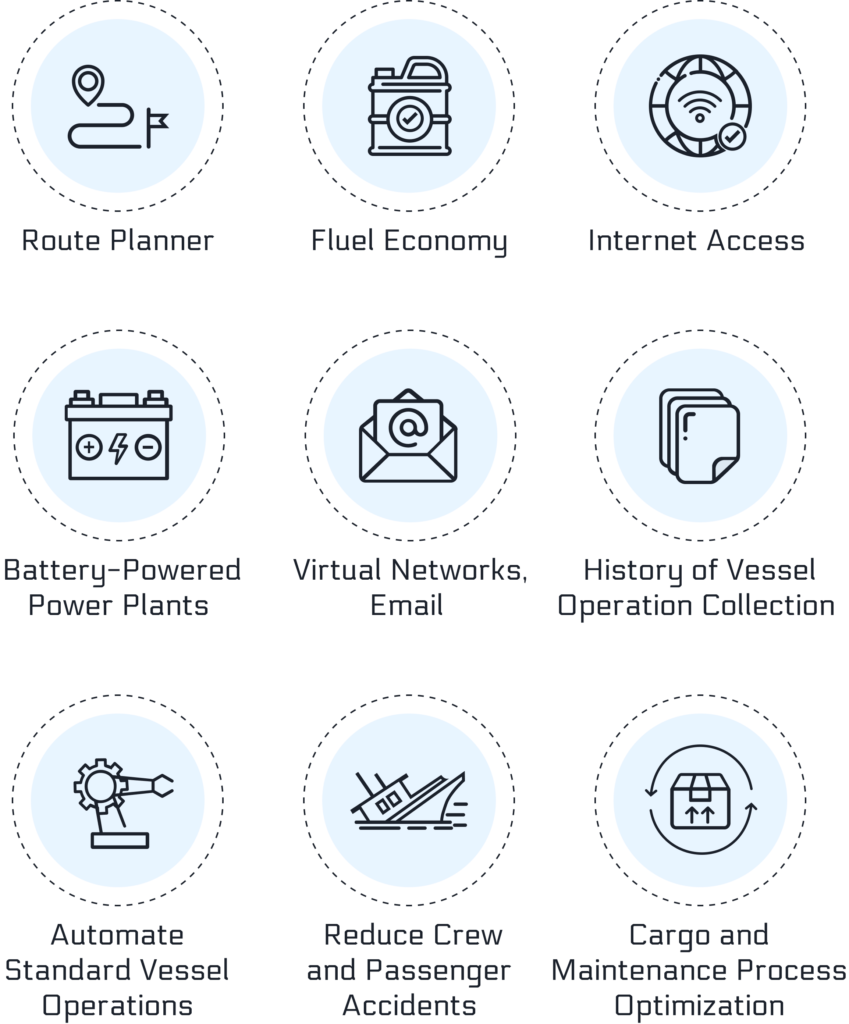Previously the main obstacle that slowed down the implementation of new technologies and services in the maritime industry was limited connectivity. So transferring large data volumes in time was completely impossible. Thanks to IoT technologies today this issue is resolved and we can consider strategic decisions for industry development. Some shipping companies are already taking advantage of the market. This is due to the use of innovative solutions in their supply chains.

A key factor in realizing these opportunities and enabling the next efficiency leap in maritime logistics is the use of data on a much larger scale than in the past.
Machine Learning in Port Operations: Digitalization is the Next Step
Creating value from data with advanced analytics and machine learning is very useful for shipping companies. It can take place along maritime supply chains, in ports, and in shipping companies. Implementing benefits requires the global digitization of industry, so maritime participants should be ready for decisive changes. Сompanies are increasingly turning to data science for easy and seamless integration of technologies into processes.
A new visibility-level the maritime transport allows to have more flexible and dynamic digital supply chains that reduce inefficiencies and synchronize operations. So let’s see how digital transformation accelerates shipping-chain work.
Digital Supply Chains
Digital supply chains provide a new level of operational efficiency in maritime logistics. Important functionality can work interconnected creating a single system of connections. It will ensure and facilitate the exchange of data between shipping lines, port services, cargo handling operations, clearance agencies, and with other transport networks.
The key points we can achieve by supply chain digitization are unifying and ensuring new optimizing stability:
Real-time visibility
New technologies help not only track the location of a ship at sea but also give the advantage to monitor all system conditions to avoid dangerous situations. Systems based on machine learning and artificial intelligence collect data 24/7. If they detect anomalies, they are automatically forwarded to the control center for appropriate adjustments. This helps to increase the safety of the ship and predict dangerous situations when they can still be influenced.
Reliable forecasts
Companies implement ML marine data in order to predict routes and achieve goals more efficiently. By analyzing the past experience of shipping routes, machine learning technology will suggest a better and better route. It takes into account everything: port queues, fuel consumption, ship loading, system status, and external weather factors. Of course, this will lead to important optimization – there will be no downtime in queues and fuel overspending.
Increased visibility of individual shipments
Today, the retail industry has its own demands. Customers expect high-quality service, fast and cheap delivery, and the convenience of product tracking. Being able to track your product has a very positive impact on your company’s brand. This allows it to raise its rating and level of customer service much higher than companies that do not. The ship’s visibility allows you to monitor the cargo, as well as the conditions of its transportation, for example, temperature and humidity level. This is important for some shipments that require special transportation conditions to prevent returns.
With big amounts of data also expand companies’ vulnerable surfaces and present serious cybersecurity challenges. In many industries, the number of suppliers is increasing. Most third-party vendors have their own vendors (or “third parties”). They depend on shared access to networks and data. Enterprises can manage the most critical risks and build quality control and compliance standards into their supplier contracts, and implement updates and fixes. Continually educating employees is the key aspect of supply chain cyber risk. Whether or not they monitor third-party relationships or supply chain logistics, all employees in a business should be aware of the cyber security threat landscape and understand their roles in cyber preparation, monitoring and response.

Digital Port
Ports must respond quickly to changing conditions. Given their multitasking nature, they must provide efficient cargo handling and storage, provide additional logistics services, and connect with various modes of transport inland. As an added benefit, smart ports can promise synchronized timing of ship arrivals and departures. This can reduce time wasted in queues.
Through information exchange and data-based predictions, we can better manage all processes inside a digital port and coordinate, opening up opportunities to reduce costs and increase efficiency along digital supply chains.
A good example is a Danish startup that uses AI and ML to improve operational efficiency while handling shipping containers. Blockshipping facilitates container terminal optimization and recommends their arrangement based on shipping dates.
Otherwise, containers are stacked randomly at the terminals which causes unnecessary shuffle moves and delays in container shipping. This system keeps on a simple logic: containers with the highest dwell time are arranged at the base and others follow suit in a descending dwell time order. This enables container handling teams to increase throughput capacity.

Port-centered innovations can especially be found in the physical handling of goods, loading units, and modes of transport as well as in information technology to optimize port calls. Completely connected ports are a vision for the future – but many measures we can implement now for port authorities or terminal operators. Machine learning ports solve today’s issues and give a big push to develop that happens under increasing transport volumes.
Digital Ships
Digitalization has invaded the maritime industry as well and it is making modern ships sail comfortably to the future. Today, new vessels increasingly resemble cyber-physical systems, where onboard software components connect mechanical and electronic parts via a dedicated data infrastructure. As a result, current data from all systems, components, and information processes on board is permanently available as a basis for improving ship operation. They are the main driving force for the next leap in maritime transport efficiency. With the comprehensive availability of digital data in real-time, its seamless exchange, and systematic analysis, we can expect far-reaching changes in the practice of ship operation. Fields of innovations include the individual systems on board, the entire operational spectrum of a ship, and the way entire fleets are managed.
The important innovation field is navigation and ship control, with developments such as smart nautical assistance systems, augmented reality for remotely-controlled vessels and even completely autonomous maritime surface ships. And, of course, we will be able to avoid dangerous situations and system failures. It is important to anticipate and resolve them before the start of shipment.
Machine learning in maritime logistics allows you to optimize work and establish an uninterrupted rhythm of deliveries, taking into account many factors. Shipping company owners that use marine ML can offer better quality services while spending fewer resources and getting more profit.
Conclusion
Harnessing the power of digital technology in the maritime sector would lose many of the critical challenges it is currently facing. One of the most valid and useful steps to an innovative future is establishing an integrated and transparent network. She helps all relevant stakeholders easily track physical goods and information flow. There is one specific reason: digitalizing the port ecosystem provides tangible value added for all participants.
Machine learning in maritime logistics allows you to optimize work and establish an uninterrupted rhythm of deliveries, taking into account many factors. Shipping company owners that use marine ML can offer better quality services while spending fewer resources and getting more profit.
Digital supply chain management suits many different business models across the supply chain, from manufacturers to retailers. However, many port players either fail to come up with a clear vision, do not select the right initiatives, or don’t manage to strictly execute their strategy.





